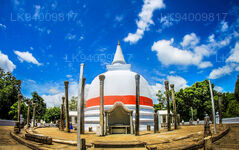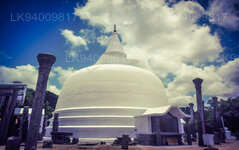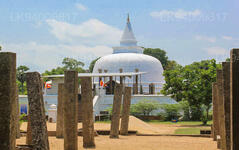
アヌラーダプラの宿泊施設
아누라다푸라는 스리랑카 북중부 지방에 속합니다. 아누라다푸라는 스리랑카의 고대 수도 중 하나로, 잘 보존된 고대 스리랑카 문명 유적지로 유명합니다. 현재 유네스코 세계문화유산으로 지정된 이 도시는 스리랑카의 현재 수도 콜롬보에서 북쪽으로 205km 떨어져 있습니다.
Lankaramaya (ලංකාරාමය)
Lankaramaya in Sri Lanka: A Temple with Over Two Millenia of History
The tale of the temple Lankaramaya in Sri Lanka is the stuff of legend. The year 103 BC was a memorable year for the King Walagamba (also known as Vattagamini Abaya) of Anuraddhapura. As the rightful king he had been attacked by invaders of the kingdom, and during that year he hid out at a place called Silasobha Khandaka and planned their defeat. His plans worked out well and the invaders were destroyed in the same year, enabling him to be enthroned following the failed invasion.
Silasobha Khandaka held a very special place in his memories, as the place that saved his life and from where he started on the road to his reign. Therefore, he built a stupa in its memory and named it Silasobha Khandaka Cetiya. The stupa was similar in architecture to the Thuparama, the first stupa to be built after the establishment of Buddhism in Sri Lanka in 250 BC. It was built with 88 pillars supporting the roof of the vatadage which appears to have been 45 feet in diameter. The vatadage was a roofed hall like structure that surrounded the actual stupa in the centre, with the entire structure built at 10 feet above ground level.
Lankaramaya in Sri Lanka: Present day status of the Temple
Today the actual stupa has been renovated, but little remains of the vatadage except the ruins of a few broken pillars in the middle of the large courtyard. The name of the stupa too has been changed from Silasobha Khandaka Cetiya to the simpler Lankaramaya.
Lankaramaya, along with the Elephant pond and the old underground canal network (dating back hundreds of years) are excellent examples of the complex architecture used millenia ago. They are interesting sites for archeology and histoty lovers. Lankaramaya is definitely a great place to visit on your holiday to Sri Lanka’s Ancient Kingdom Anuraddhapura.
아누라다푸라 지구 소개
아누라다푸라는 스리랑카 북중부 지방에 속합니다. 아누라다푸라는 스리랑카의 고대 수도 중 하나로, 잘 보존된 고대 스리랑카 문명 유적지로 유명합니다. 현재 유네스코 세계문화유산으로 지정된 이 도시는 스리랑카의 현재 수도 콜롬보에서 북쪽으로 205km 떨어져 있습니다. 신성한 도시 아누라다푸라와 그 주변에는 수많은 유적이 있습니다. 유적은 다고바, 수도원, 그리고 포쿠나(연못)의 세 가지 유형의 건물로 구성되어 있습니다. 이 도시는 고대 세계에서 가장 복잡한 관개 시스템을 갖추고 있었으며, 국가의 건조 지대에 위치해 행정부는 토지에 관개를 위해 많은 탱크를 건설했습니다. 대부분의 민간인은 싱할라족이며, 타밀족과 스리랑카 무어족이 이 지역에 거주합니다.
북중부 지방 소개
북중부 지방은 이 나라에서 가장 큰 지방으로 전체 국가 면적의 16%를 차지했습니다. 북중부 지방은 폴로나루와와 아누라다푸레라는 두 개의 지구로 구성되어 있습니다. 아누라다푸라는 스리랑카에서 가장 큰 지구입니다. 면적은 7,128km²입니다. 북중부 지방은 투자자들이 사업을 시작할 수 있는 수많은 잠재력을 가지고 있으며, 특히 농업, 농업 기반 산업 및 축산 분야가 그렇습니다. 북중부 지방 주민의 65% 이상이 기초 농업 및 농업 기반 산업에 의존합니다. NCP는 이 지방에 중대형 탱크가 3,000개 이상 있기 때문에 "웨우 벤디 라제"라고도 불립니다. 스리 마하 보디야, 루완웰리 세야, 투파라마 다게바, 아바야기리 수도원, 폴로나루와 랑코트 웨헤라, 란카티레이크가 두렵습니다.

















